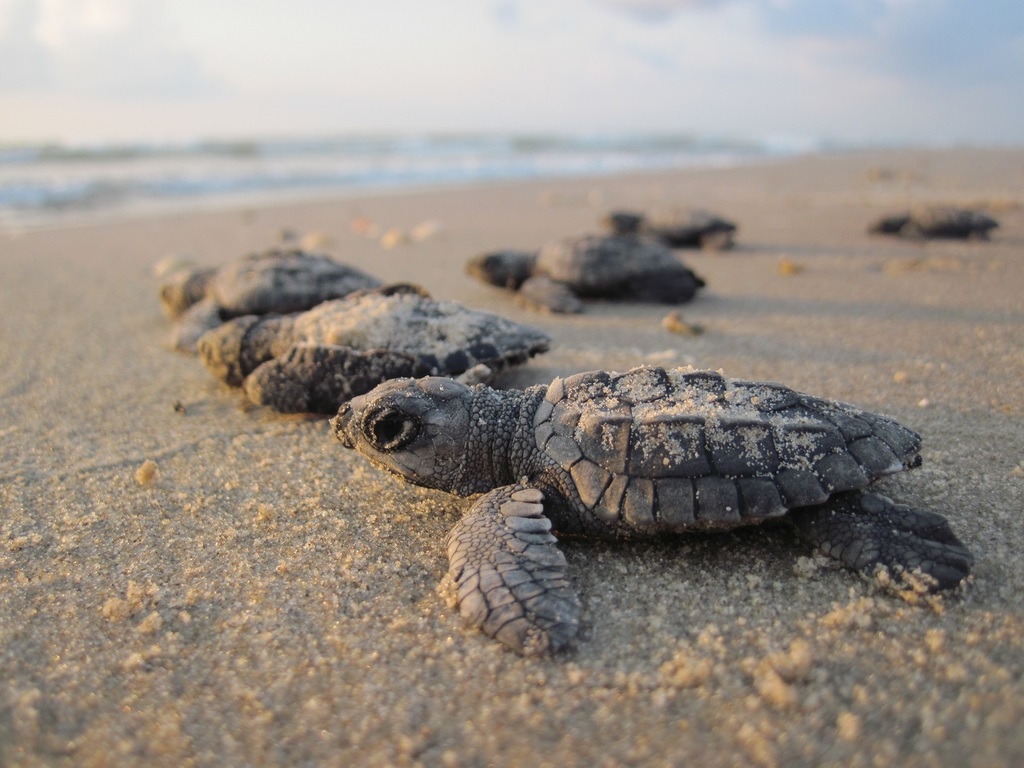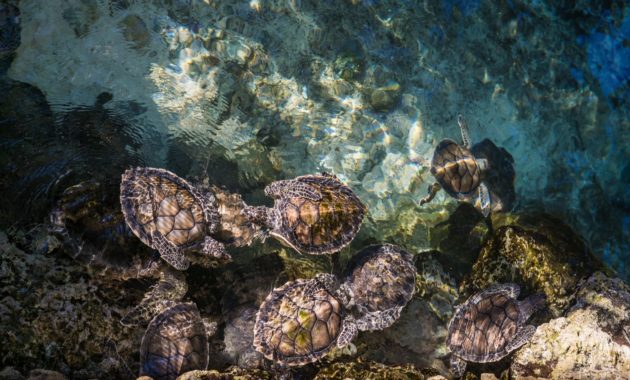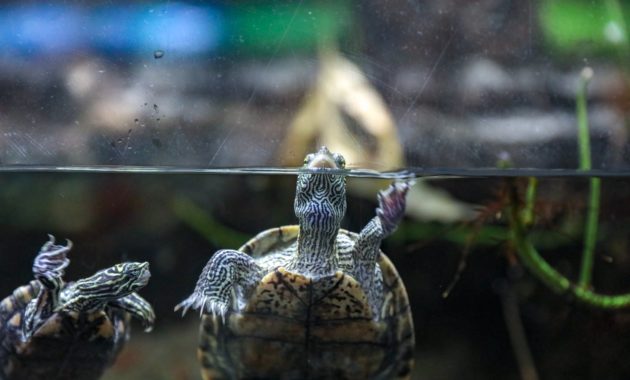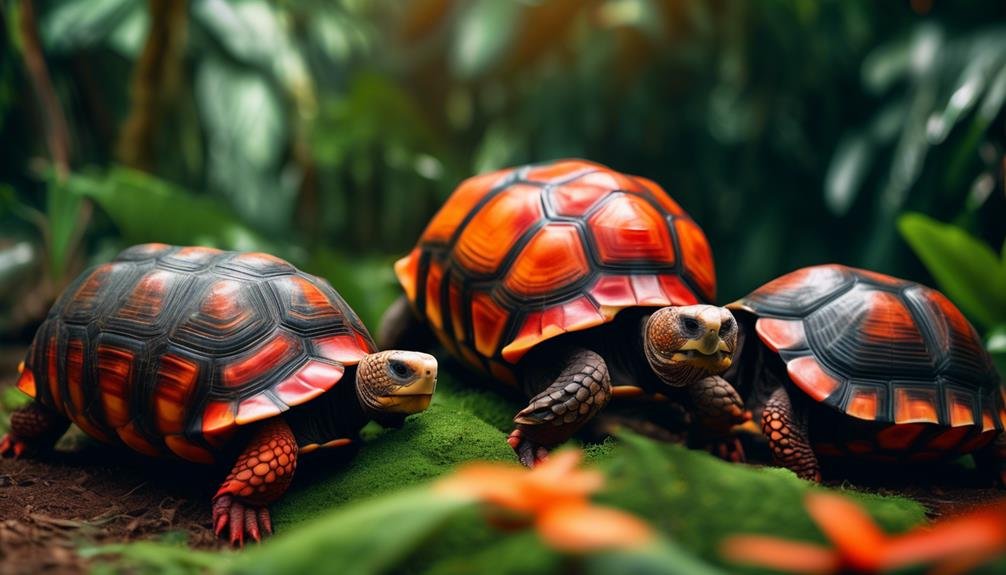
Are you ready to embark on a journey into the enchanting world of red footed tortoises?
Prepare to be captivated by their unique charm and mesmerizing presence. These incredible creatures possess a beauty and allure that is truly unparalleled.
From their eye-catching carapace to their stunning red scales, every aspect of their appearance is sure to leave you in awe.
But there's so much more to discover beyond their physical attributes.
So, are you ready to uncover the secrets and delights that await you in the world of red footed tortoises?
Key Takeaways
- Red Footed Tortoises are a popular and easy-to-care-for pet breed, making them suitable for beginners.
- They have a distinct appearance with a medium-sized body, oval carapace, and small head with large eyes.
- Native to southern Central America and much of South America, they are found in grasslands, savannahs, and dry forests.
- Red Footed Tortoises have an omnivorous diet, enjoying a variety of vegetables, fruits, and occasional animal protein.
General Information and Characteristics
Red Footed Tortoises are a popular pet breed known for their easy care and beginner-friendly nature. These medium-sized terrestrial tortoises have a lifespan of 50+ years, making them a long-term companion. With their oval carapace, small head, and large eyes, they have a distinctive appearance. The highly domed carapace has raised or smooth scutes, and the marginals appear tucked under the sides but flare over the limbs.
As for their habitat, they are found in grasslands, savannah, and dry forest areas of southern Central America and much of South America. Their skin is mostly black, and their carapace can be gray, black, or brown with areas of tan or yellow. They have bright red scales or marks on their lower jaw and head, and their tail and legs have yellow, red, or orange scales or patches.
When it comes to their environment and enclosure, it's important to provide a sturdy enclosure with walls a few inches below the ground. Avoid using fences or walls that the tortoise can see through. Young tortoises can be raised indoors, while adults prefer outdoor enclosures. They are tolerant to high temperatures and can handle cooler temperatures down to 45F with a heated hiding box.
In terms of care and diet, they have an omnivorous diet, including vegetables such as turnip greens, watercress, and dandelion greens, as well as fruits like berries, apples, papaya, and melon. They should also receive animal protein once a week, such as roaches, crickets, or mealworms. It's important to supplement their diet with a multi-vitamin/mineral and calcium product.
While they have curious personalities and are a pleasure to watch, they shouldn't be handled regularly to avoid stress.
Size and Type
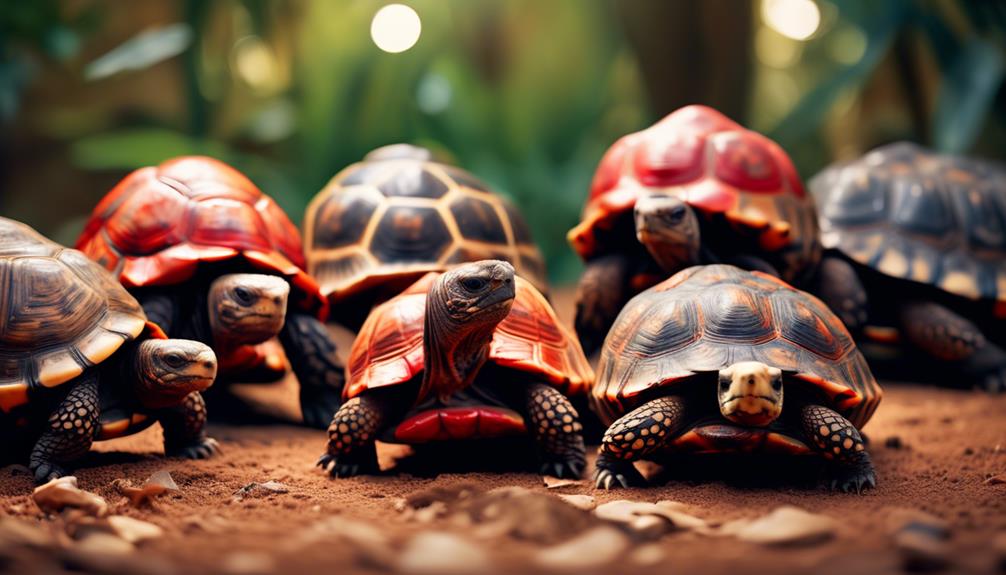
When considering Red Footed Tortoises, it's important to understand their size and type. These tortoises are considered medium-sized, making them a suitable choice for pet owners looking for a manageable-sized reptile. Red Footed Tortoises are terrestrial, meaning they spend most of their time on land rather than in water.
Their oval-shaped carapace is highly domed, with raised or smooth scutes. The marginals of their carapace appear tucked under their sides but flare over their limbs. As they age, the growth rings on their carapace may become smooth.
These tortoises have a wide distribution range, native to southern Central America and much of South America.
Lifespan and Popularity

As you continue to explore Red Footed Tortoises, it's important to delve into their lifespan and popularity among reptile enthusiasts. These captivating creatures have a lifespan of over 50 years, making them a long-term commitment for pet owners. Their popularity stems from several factors, including their ease of care and availability as pets.
Here are five key points to consider:
- Long lifespan of 50+ years
- Highly sought after as a pet breed
- Easy to find and acquire
- Simple to care for, suitable for beginners
- Endearing behaviors and curious personalities
These factors contribute to the widespread appeal of Red Footed Tortoises, making them a favorite among reptile enthusiasts. Their enchanting charm and longevity make them a rewarding companion for many years to come.
Easy to Find and Care For
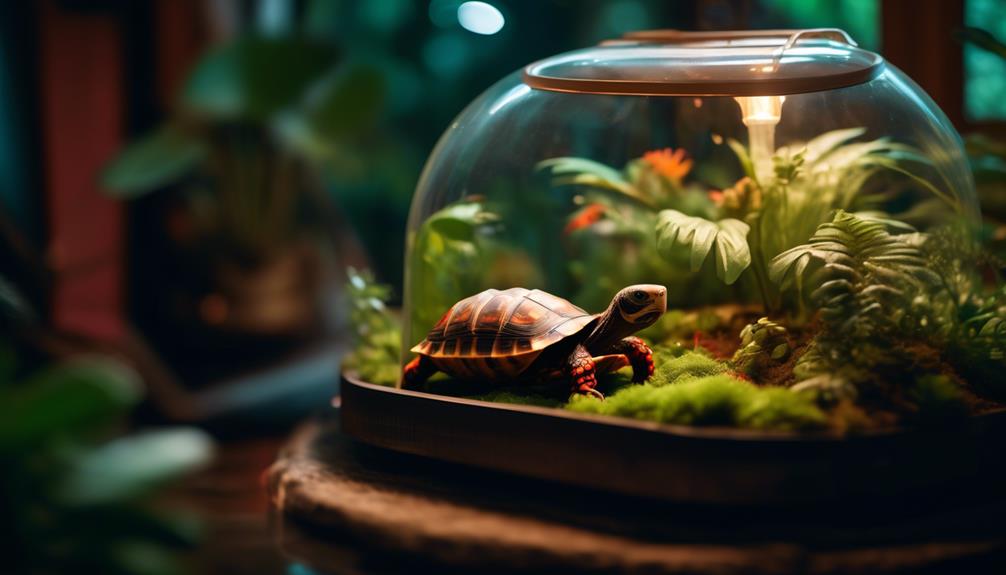
Finding and caring for Red Footed Tortoises is a breeze due to their availability and low-maintenance nature. These charming creatures are easy to find and acquire, making them a popular choice for pet owners. Additionally, they are suitable for beginners, as they require minimal care and attention. To further illustrate their simplicity, take a look at the table below:
| Easy to Find | Easy to Care For |
|---|---|
| Widely available in pet stores and online | Requires minimal grooming |
| Not endangered or protected species | Simple diet of vegetables, fruits, and occasional animal protein |
| Breed readily in captivity | Tolerant to a wide range of temperatures |
With their easy availability and straightforward care requirements, Red Footed Tortoises make a delightful and hassle-free addition to any pet-loving household.
Physical Appearance and Colors
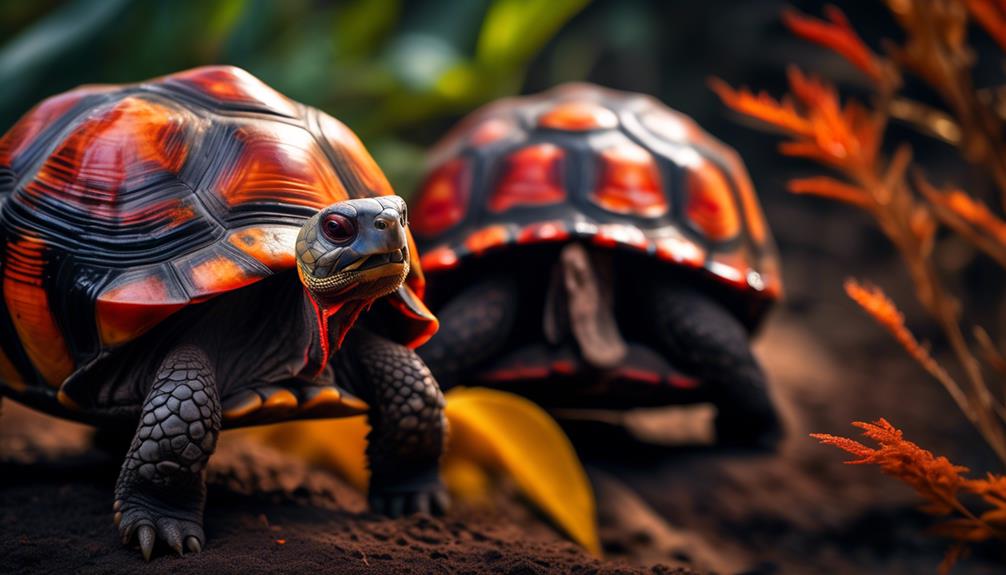
Red Footed Tortoises display a distinct physical appearance with unique colors that make them stand out among other tortoise species. Their physical features include:
- Oval carapace
- Small head and large eyes
- Highly domed carapace with raised or smooth scutes
- Marginals appear tucked under sides but flare over limbs
- Bright red scales or marks on lower jaw and head, with tail and legs having yellow, red, or orange scales or patches.
Their skin is mostly black, while the carapace can be gray, black, or brown with areas of tan or yellow. The plastron is black, brown, or dull yellow.
These vibrant colors, especially the red scales and patches, add to their enchanting charm and make them a joy to observe.
Habitat and Distribution
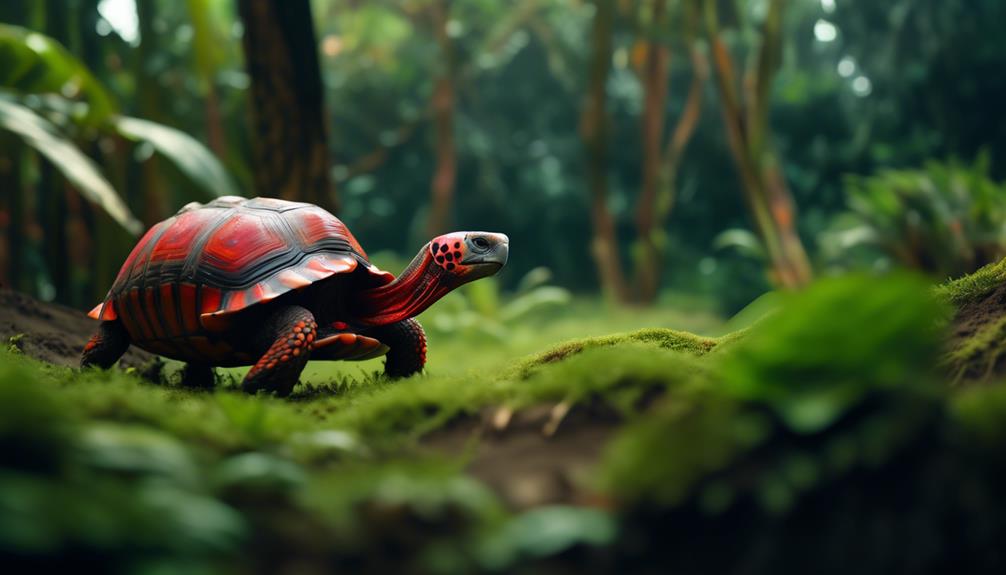
After admiring the vibrant colors and unique physical features of Red Footed Tortoises, it's important to understand their natural habitat and distribution.
These tortoises are found in grasslands, savannahs, and dry forest areas. They may also be seen in rainforests near open habitats.
Red Footed Tortoises are native to southern Central America and much of South America. Their skin is mostly black, while their carapace can be gray, black, or brown with areas of tan or yellow. They've bright red scales or marks on their lower jaw and head, and their tail and legs have yellow, red, or orange scales or patches. Their plastron is black, brown, or dull yellow.
Understanding their habitat and distribution is crucial in providing the right environment for these enchanting creatures.
Enclosure and Environment
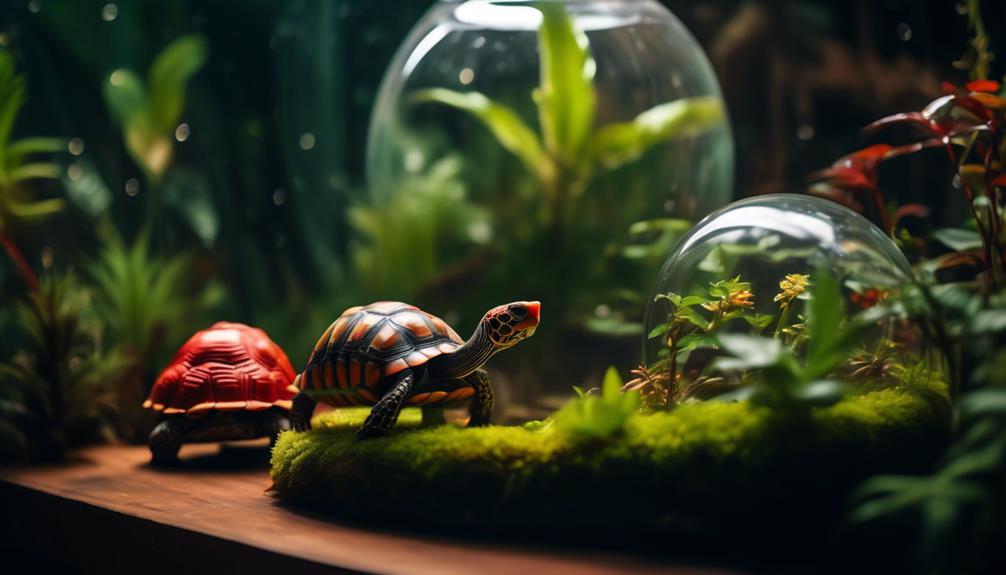
To provide a suitable habitat for Red Footed Tortoises, it's important to create an enclosure that has sturdy walls and is a few inches below the ground. Here are some key points to consider:
- Avoid using fences or walls that the tortoise can see through.
- Young tortoises can be raised indoors, while adults prefer outdoor enclosures.
- Ensure there are shaded spots and access to water to help them tolerate high temperatures.
- Provide a heated hiding box for cooler temperatures down to 45F.
- The enclosure should be spacious enough for the tortoise to roam and explore.
Creating an appropriate environment for Red Footed Tortoises is crucial for their well-being. By following these guidelines, you can ensure that your tortoise has a safe and comfortable space to thrive.
Temperature Tolerance and Shelter
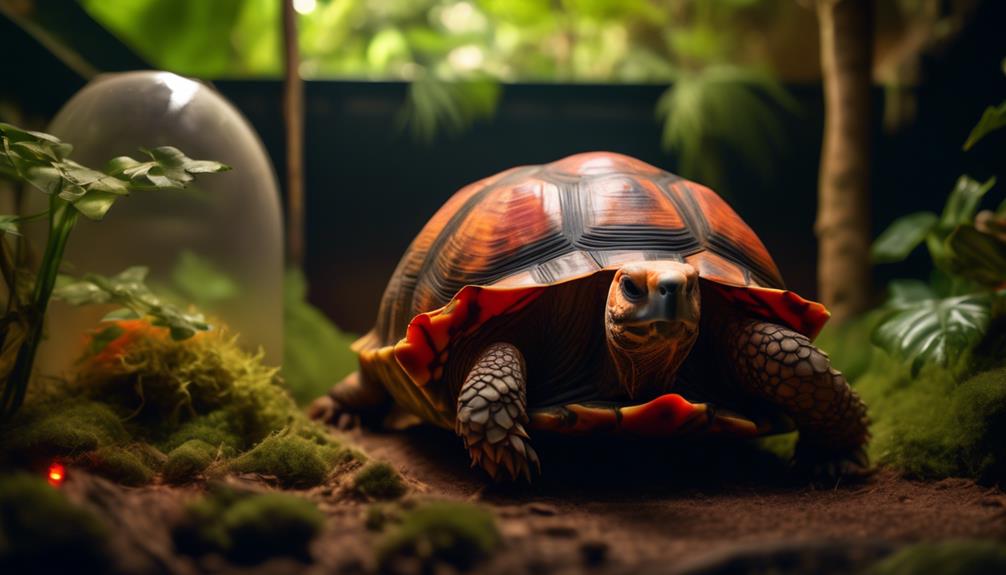
Creating a suitable shelter and ensuring temperature tolerance is essential for the well-being of Red Footed Tortoises. These tortoises are tolerant to high temperatures, but they also require shaded spots and access to water to stay cool. In cooler temperatures, they can handle down to 45F with the help of a heated hiding box. When setting up their enclosure, it is important to provide sturdy walls and ensure that the enclosure is a few inches below the ground. Avoid using fences or walls that the tortoise can see through. Young tortoises can be raised indoors, while adults prefer outdoor enclosures. Here is a table summarizing the temperature tolerance and shelter requirements for Red Footed Tortoises:
| Temperature Tolerance | Shelter Requirements |
|---|---|
| Tolerant to high temperatures | Shaded spots |
| Can handle down to 45F | Heated hiding box |
| Sturdy enclosure walls | |
| Enclosure below ground | |
| No see-through fences |
Care and Diet
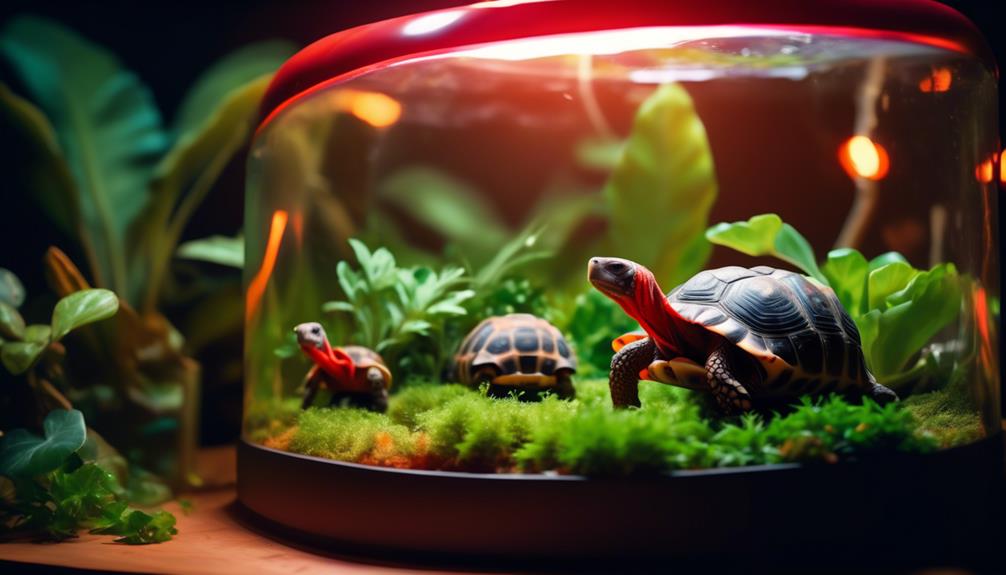
Now, let's move on to discussing the care and diet of Red Footed Tortoises, ensuring their well-being and overall health.
- Provide an omnivorous diet with a variety of options including vegetables like turnip greens, watercress, and dandelion greens.
- Include fruits such as berries, apples, papaya, and melon in their diet.
- Offer animal protein once a week, such as roaches, crickets, and mealworms.
- Supplement their diet with a multi-vitamin/mineral and calcium product.
- Avoid handling them regularly to prevent stress.
Red Footed Tortoises have curious personalities, making them a pleasure to watch. They've endearing behaviors that can captivate any tortoise enthusiast. By ensuring they've a balanced diet and providing proper care, you can keep your Red Footed Tortoise healthy and happy for many years to come.
Omnivorous Diet Options
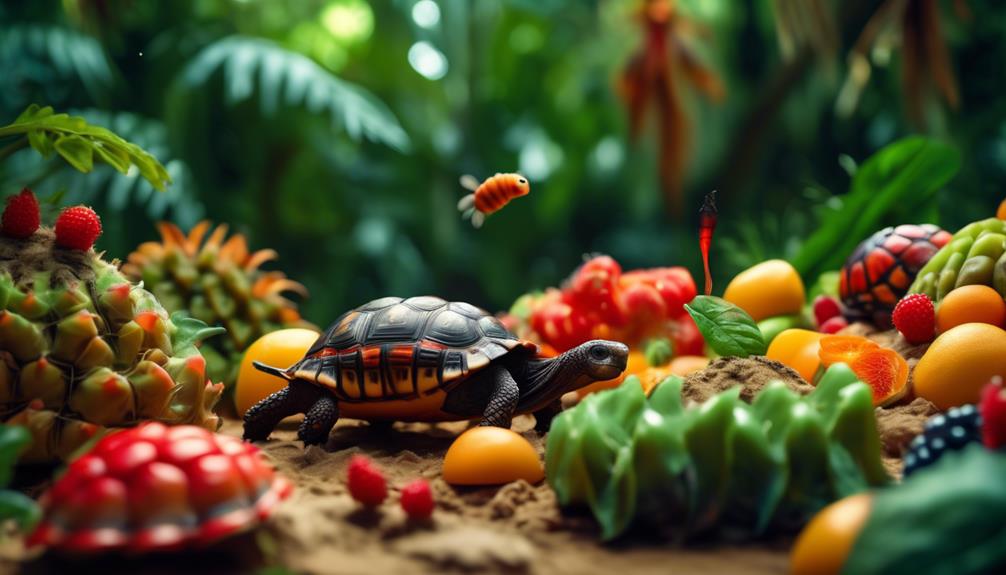
When providing an omnivorous diet for your Red Footed Tortoise, there are various options to choose from. To ensure a balanced diet, you can offer a variety of vegetables such as turnip greens, watercress, and dandelion greens. These leafy greens provide essential nutrients and vitamins.
Additionally, fruits like berries, apples, papaya, and melon can be included in their diet as a source of natural sugars and additional vitamins.
It's also important to incorporate animal protein into their diet once a week. This can be in the form of roaches, crickets, mealworms, or other small insects.
Remember to supplement their diet with a multi-vitamin/mineral and calcium product to meet their nutritional needs.
Handling and Behavior
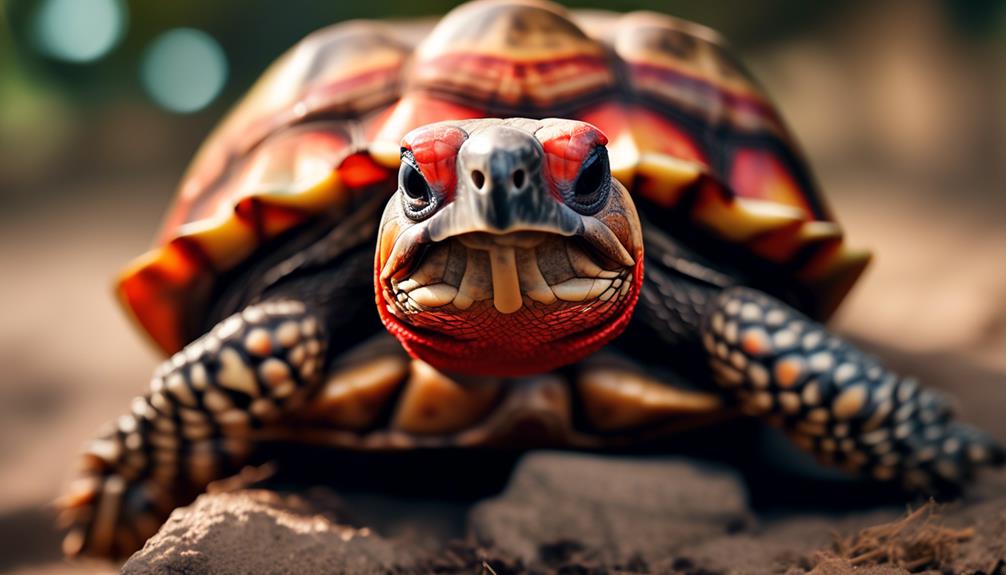
To better understand the behavior and handling of Red Footed Tortoises, let's dive into their fascinating personalities and unique traits.
- Red Footed Tortoises have curious personalities and can be a pleasure to watch.
- They exhibit endearing behaviors that make them a popular pet breed.
- It's important to note that they shouldn't be handled regularly to avoid stress.
Red Footed Tortoises are generally easy to care for and suitable for beginners. With their highly domed carapace and small head with large eyes, they have a distinct appearance.
These traits contribute to their charm and make them a wonderful addition to any reptile enthusiast's collection. However, it's crucial to provide them with a suitable environment and diet to thrive.
Pleasure of Observing
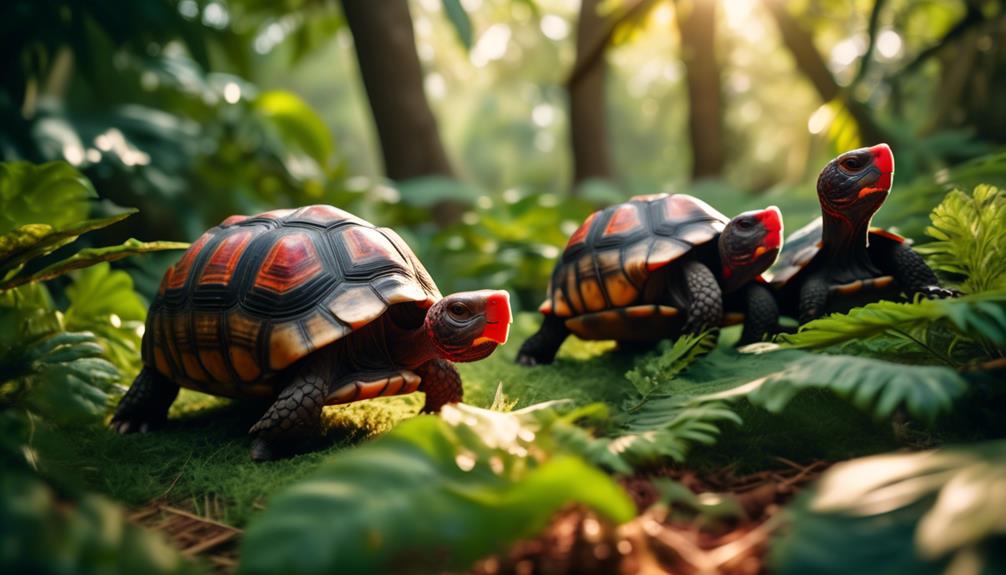
Experience the joy and wonder of observing Red Footed Tortoises as they go about their daily activities. These fascinating creatures are a pleasure to watch, with their curious personalities and endearing behaviors. To further engage you, here is a table providing general information about Red Footed Tortoises:
| Characteristics | Appearance |
|---|---|
| – Size: Medium | – Skin: Mostly black |
| – Type: Terrestrial | – Carapace: Gray, black, or brown with areas of tan or yellow |
| – Lifespan: 50+ years | – Bright red scales or marks on lower jaw and head |
| – Popular pet breed | – Tail and legs have yellow, red, or orange scales or patches |
| – Easy to find and acquire | – Plastron: Black, brown, or dull yellow |
| – Easy to care for |
Observing these tortoises in their natural habitat or in an enclosure can be a rewarding experience. From their slow and deliberate movements to their interactions with their environment, you'll be captivated by their daily routines. So sit back, relax, and enjoy the enchanting charm of Red Footed Tortoises.
Endearing Behaviors
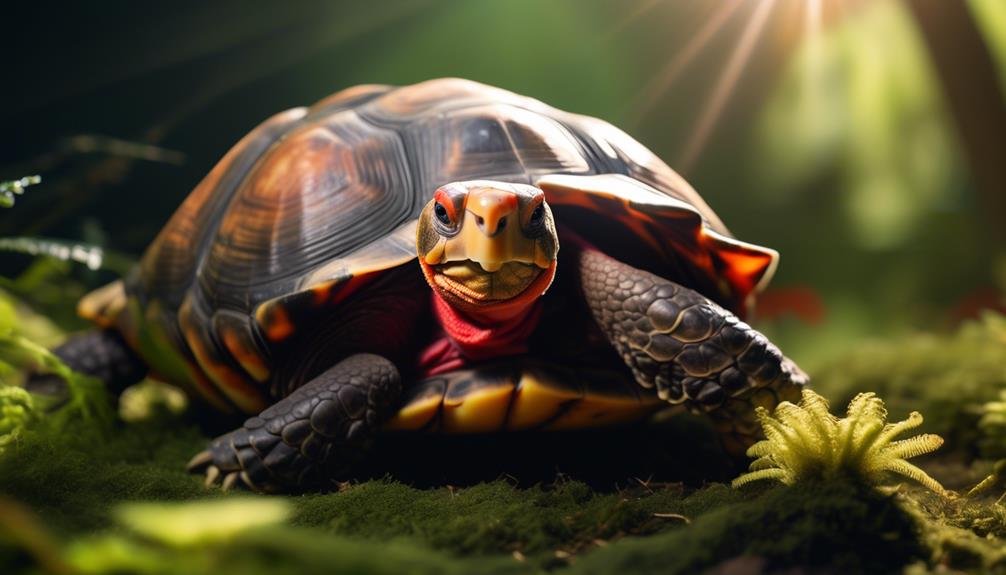
Have you ever wondered what makes Red Footed Tortoises' behaviors so endearing? These delightful creatures possess a range of endearing behaviors that make them a joy to observe. Here are five endearing behaviors that will surely warm your heart:
- Gentle and docile nature: Red Footed Tortoises are known for their calm and gentle demeanor, making them great pets for both children and adults.
- Curiosity and exploration: These tortoises have a natural curiosity and love to explore their surroundings, often poking their heads out and investigating their environment.
- Playful interactions: Red Footed Tortoises have been observed engaging in playful behaviors, such as nudging objects with their noses or pushing items around.
- Social bonding: These tortoises are capable of forming strong bonds with their owners, often recognizing and responding to familiar faces and voices.
- Basking in the sun: Red Footed Tortoises love to bask in the warm sun, stretching out their limbs and soaking up the rays, which isn't only adorable but also essential for their health.
These endearing behaviors make Red Footed Tortoises truly enchanting companions to have in your life.
Frequently Asked Questions
Are Red-Footed Tortoises Nocturnal or Diurnal?
Red-footed tortoises are diurnal, meaning they are active during the day. They enjoy basking in the sun and exploring their surroundings. You can observe their enchanting charm and behaviors during daylight hours.
Can Red-Footed Tortoises Swim?
Yes, red-footed tortoises can swim. They are capable swimmers and enjoy being in water. However, it's important to provide them with a safe and shallow area to prevent any accidents.
How Often Do Red-Footed Tortoises Lay Eggs?
Red-footed tortoises lay eggs once or twice a year. The female digs a nest and lays around 3-5 eggs. Incubation can take up to 150 days. It's a fascinating process to witness!
Do Red-Footed Tortoises Hibernate?
Yes, red-footed tortoises hibernate. They require a cool, dark place to rest during the winter months. Make sure they have a suitable hiding spot and monitor temperature and humidity levels.
Can Red-Footed Tortoises Be Kept With Other Turtle Species?
No, red-footed tortoises should not be kept with other turtle species. It is important to provide them with their own enclosure to ensure their well-being and prevent any potential conflicts or stress.
Are Red Footed Tortoises and Hermann’s Tortoises Suitable as Pets?
Red Footed Tortoises and Hermann’s Tortoises make great pets for reptile enthusiasts. They are known for their secrets of longevity revealed in captivity, often living for several decades. However, potential owners should be aware of their specific care requirements and their long lifespan before bringing them home.
Conclusion
In conclusion, if you're seeking a charming and easy-to-care-for pet, look no further than the Red Footed Tortoise.
With its unique appearance, omnivorous diet, and enchanting behaviors, these captivating creatures are a joy to watch.
Whether you're a beginner or experienced pet owner, the Red Footed Tortoise will bring a touch of magic to your life.
So why wait? Discover the enchanting charm of these delightful tortoises today.

